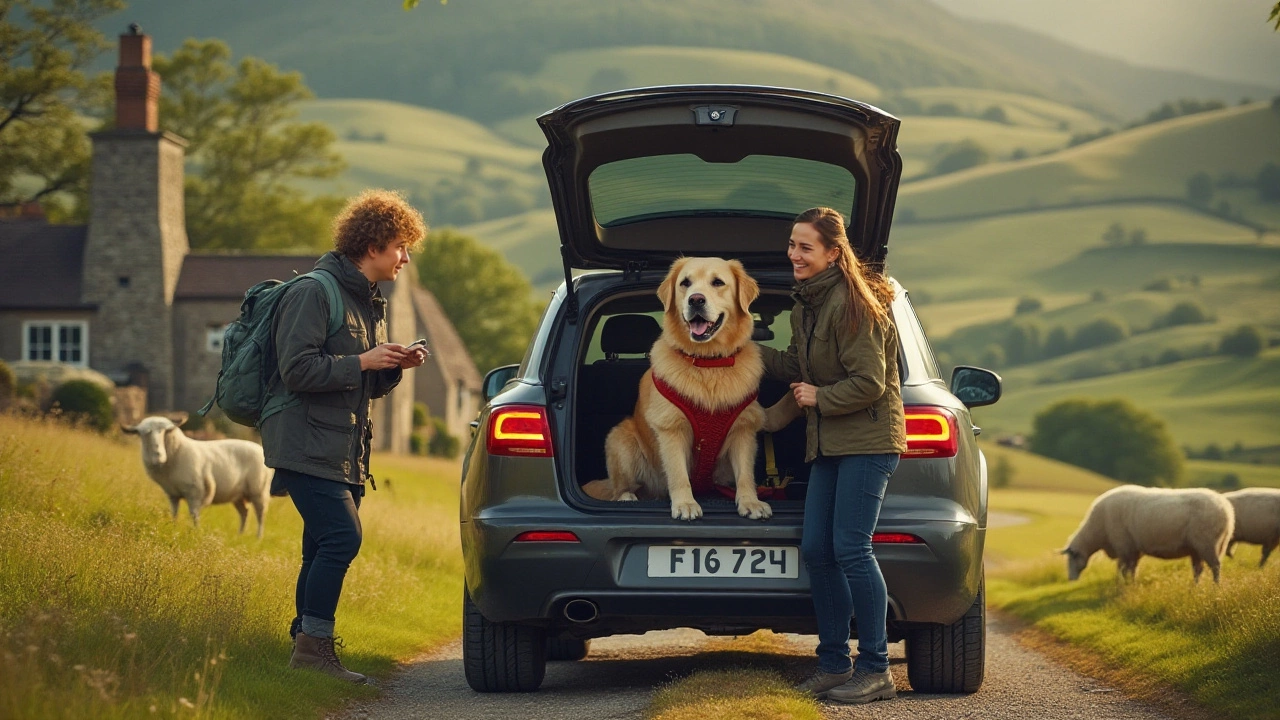So, you've decided to embark on an adventure with your 70-pound bundle of joy—the furry kind. Traveling with a large dog can be a daunting task, but with the right preparation and mindset, it can turn into an experience filled with wagging tails and cherished memories. Whether you're planning a road trip across states or a flight to faraway lands, understanding some key strategies will help make the journey smoother and more comfortable for both you and your canine companion.
From choosing ideal destinations that welcome your four-legged friend with open arms to knowing what essentials to pack, this guide will walk you through every step of the way. You'll also discover practical tips for making car rides safe and airlines trips hassle-free, backed by real-world experiences and insights that will inform and inspire. The open road or the sky above awaits, and with the wagging tail by your side, it's time to explore the world together.
- Choosing Dog-Friendly Destinations
- Packing Essentials for Your Canine Companion
- Navigating Car Travel with a Big Dog
- Airline Travel: Tips and Regulations for Large Dogs
Choosing Dog-Friendly Destinations
Nothing ruins a trip faster than realizing your chosen destination isn't as welcoming to four-legged guests as you'd hoped. Thankfully, as the trend of pet travel rises, more places are rolling out the red carpet for our furry companions. Whether you're drawn to bustling urban landscapes or the tranquillity of nature, there's a destination waiting for you and your large dogs.
Urban Escapes
Cities like Austin, TX, and Portland, OR, pride themselves on being remarkably dog-friendly. Austin’s Lady Bird Lake is an off-leash haven, while Portland offers a list of dog-friendly breweries and even hosts an annual dog film festival. Both cities boast numerous pet-friendly hotels and Airbnbs where dogs of all sizes are not just allowed but celebrated.
Nature Retreats
For those yearning for wide-open spaces, destinations like Asheville, NC, nestled near the Blue Ridge Mountains, provide a plethora of hiking trails and charming cabin rentals that accommodate large dogs. Alternatively, Glacier National Park in Montana offers scenic views and trails where leashed dogs are welcome to explore.
Essential Considerations
- Accommodation Policies: Always double-check pet policies since they can vary widely. Some accommodations may have weight restrictions or additional fees for large dogs.
- Local Regulations: Research any local leash laws or restrictions on pets in public areas. Some parks may have designated off-leash zones specifically for pets to roam free.
- Pet Amenities: Consider destinations that provide pet amenities such as dog parks, grooming salons, or pet sitting services to enhance your travel experience.
When planning your next getaway, tapping into the world of dog-friendly destinations ensures that your 70-pound best friend can enjoy the journey as much as you do. The options are vast and varied, ready to accommodate your adventurous spirit and your dog's wagging enthusiasm.
Packing Essentials for Your Canine Companion
When preparing to travel with your large dog, having a well-thought-out packing checklist ensures that your journey is as seamless as a neighborhood walk in the park. A few strategic selections can make all the difference, ensuring comfort, safety, and enjoyment during your travels.
1. Basic Needs: Food and Water
The cornerstone of your packing list should be your dog's food and water. Consider bringing a high-quality dry dog food that is easy to store and transport. Travel-sized containers or resealable bags are perfect to save space and manage portions. Don't forget a portable water bottle with an attached bowl to keep your dog hydrated on the go.
2. Security and Safety Gear
A trusted harness and leash are non-negotiable when it comes to ensuring your pet's safety, especially in unfamiliar environments. A safety harness seat belt for car travel is also essential to prevent any sudden movements that could cause distress or injury.
3. Comfort Items
Travel can be stressful, even for the most seasoned pet travelers. Bringing along familiar comfort items can ease the transition into new environments. Include your dog's favorite blanket or bed, which provides a sense of home and comfort among all the changes.
4. Health and Hygiene
Don't let hygiene take a back seat while on the road. Bring dog-friendly wipes, a supply of poop bags, and a small towel for any potential messes. An updated first-aid kit with essential supplies like band-aids, antiseptic, and any specific medication your dog requires, ensures you're prepared for any unexpected health hiccups.
5. Identification and Documentation
Before setting off on your travels, compile a package of your pet's identification and health records. This should include a recent photo of your dog, vaccination records, and any necessary travel permits or documentation, especially if you're crossing state lines or international borders.
| Item | Purpose | Recommendation |
|---|---|---|
| Portable Water Bottle | Hydration | Foldable design with built-in bowl |
| Harness Seat Belt | Safety | Adjustable, crash-tested model |
| Pet First-Aid Kit | Health | Compact with dog-specific supplies |
With a well-packed bag, adventures with your furry companion are as limitless as their curiosity. Each item in your luggage plays a pivotal role in maintaining comfort and safety, ensuring journeys filled with fond memories rather than forgotten essentials.

Navigating Car Travel with a Big Dog
Taking a 70-pound dog on a road trip across the country or even just to the local park introduces its own set of challenges. However, with thoughtful planning and a few strategic measures, you can ensure that car travel becomes an enjoyable part of your shared adventures. Here’s how to make the journey smooth and worry-free.
Safety First: Car Travel Essentials
When it comes to traveling with a large dog, safety should always be at the forefront of your mind. Start with a sturdy pet seatbelt harness or a well-ventilated crate in the back seat. These restraints not only keep your dog secure but also prevent distracted driving. In the unfortunate event of an accident, a properly secured dog has much better odds of avoiding injury.
- Harness: Look for crash-tested harnesses, particularly ones with wide straps for comfort.
- Crate: Opt for durable and crash-tested options if you have the space.
Comfort and Convenience: Preparing the Car
Creating a comfortable environment for your canine co-pilot is essential. Begin by placing a non-slip mat or a thick blanket in the back seat area where your dog will be located. This helps prevent slipping and sliding during the ride, adding comfort and security. Adequate ventilation is also crucial, so ensure air conditioning or windows allow a steady airflow, preventing overheating.
Make frequent stops to offer breaks for leg stretching, hydration, and bathroom needs. Dogs usually appreciate these stops every couple of hours, giving them a chance to alleviate stress or anxiety caused by extended periods in a moving vehicle.
Entertainment and Soothing Aids
Even the most adventurous dogs might become restless or anxious during long drives. Have a few favorite toys or chewy treats handy to keep your pup occupied and entertained. For dogs prone to car anxiety, consider using calming aids like a pheromone spray or anxiety vest to soothe their nerves. In some cases, veterinarians might suggest mild sedatives, but always as a last resort and under professional guidance.
Road Conditions and Considerations
It’s important to be mindful of the external conditions and the routes you choose. Try to avoid highly congested areas that may lead to frequent stops and starts as these can be unsettling for large dogs. Country roads or scenic routes often provide a smoother experience and can reduce stress levels for both you and your pet.
Quick Stat Table
An interesting point to note is that, according to a survey by the American Pet Products Association, about 44% of pet owners take their dogs on car trips at least once a month. This growing trend highlights the importance of optimizing vehicle travel for dogs of all sizes.
| Consideration | Suggestion |
|---|---|
| Duration of Drive | Plan frequent breaks every 2-3 hours |
| Temperature Control | Ensure adequate ventilation |
With a bit of patience and preparation, road travels with your big dog can be more than just a means to an end; it can become a cherished and integral part of your journey.
Airline Travel: Tips and Regulations for Large Dogs
Traveling with a large dog on an airplane requires more than just booking your tickets. Each airline has its set of regulations, so it's crucial to research and choose a carrier that accommodates dogs exceeding typical weight limits. Understanding these requirements not only ensures compliance but also the safety and comfort of your furry companion.
Understanding Airline Policies
Most airlines have size and weight restrictions for pets traveling in the cabin, which can be as low as 20 pounds, including the carrier. For a 70-pound dog, you'll usually need to explore options for cargo travel. Before booking, check the airline's pet policy on their website or contact customer service for tailored guidance.
Airlines such as Delta, American Airlines, and United offer specific services for transporting pets in their cargo hold. These compartments are temperature-controlled and adhere to strict safety regulations, ensuring pets are comfortable during the flight.
"Traveling with animals can be a stressful experience for both parties. It's crucial to plan ahead and understand the procedures, ensuring the comfort and safety of your pet," says Sarah Colton, Director of Pet Services at Wings and Tails Travel Agency.
Preparing Your Dog for Air Travel
Documentation and Health Checks
Before embarking on a flight, ensure your dog has a recent health certificate from a vet—generally no older than 10 days before travel. Some destinations require additional documentation or vaccinations, which varies by country. It's wise to check with the consulate of your destination for specific import regulations.
Choosing the Right Carrier
The kennel or carrier is a crucial piece of travel gear. It must be spacious enough for your dog to stand, turn, and lie down comfortably, complying with the International Air Transport Association (IATA) guidelines. Some airlines have approval stickers for compliant carriers, so it's good to confirm these details in advance.
Booking Your Flight
- Reserve Early: Pet cargo space can be limited, so book as early as possible to secure your spot.
- Direct Flights: Whenever possible, opt for nonstop flights to reduce stress on your dog and avoid potential mishaps during connections.
- Seasonal Considerations: Be mindful of the temperature at both your departure and arrival locations; some airlines restrict pet travel during extreme weather conditions.
By preparing thoroughly and understanding the specific requirements of airline travel for pets, you can alleviate many challenges. While it may involve extra steps, the joy of having your beloved dog accompany you on your adventures is undoubtedly worth the effort.
